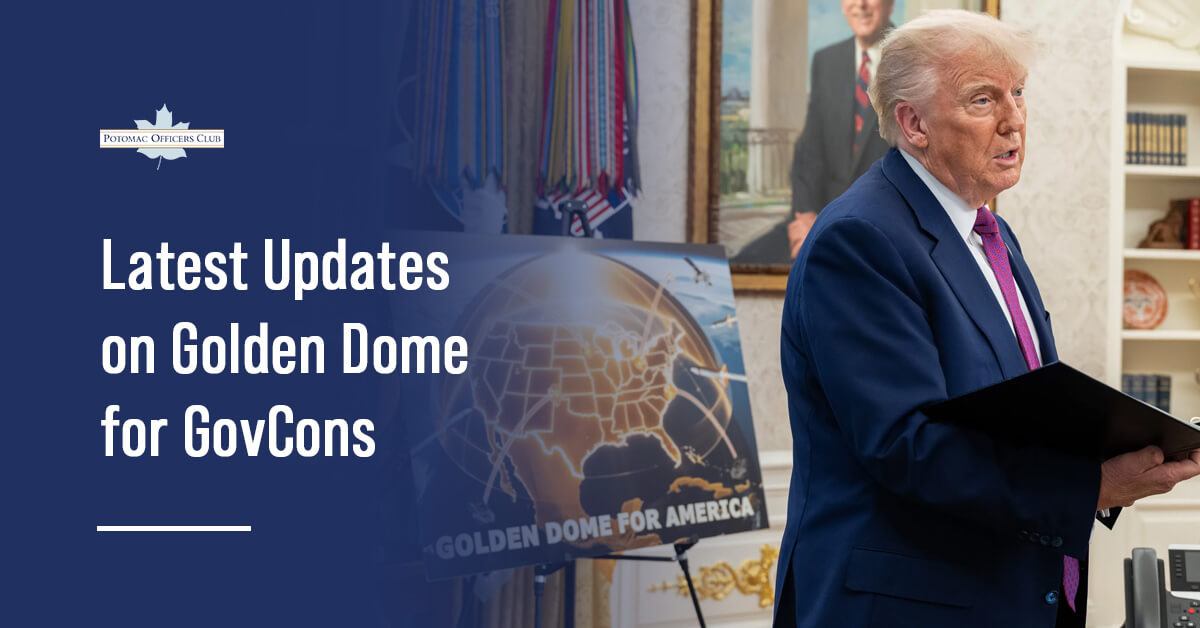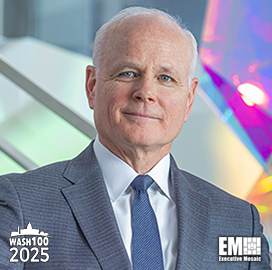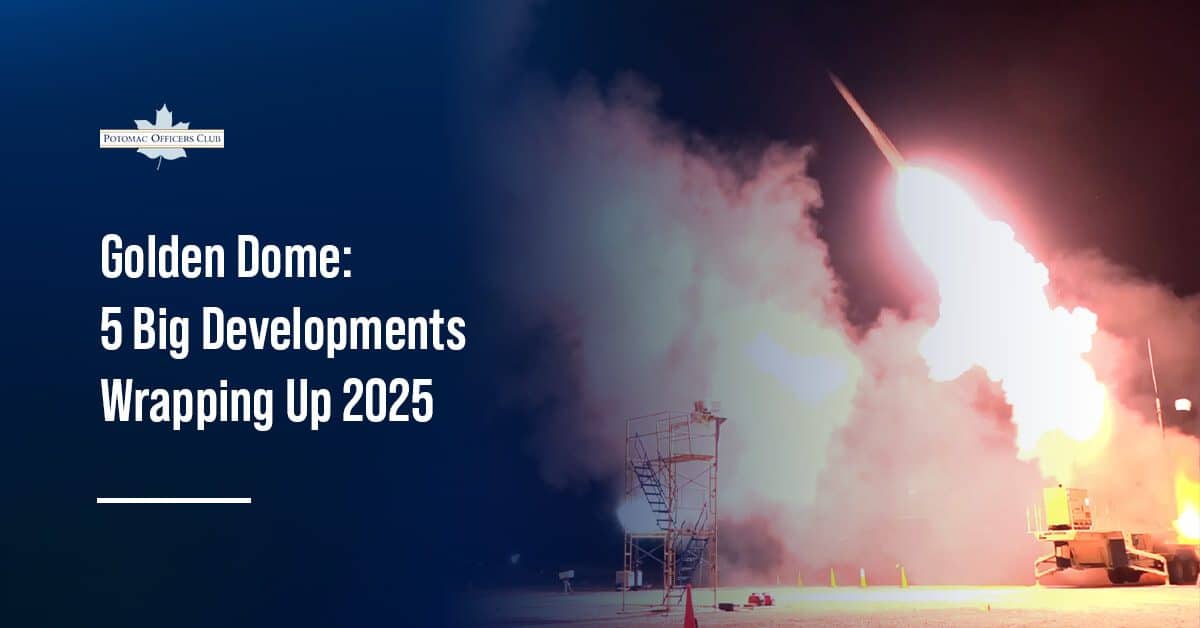
Inside Golden Dome: The GovCon Race for Billions
The Pentagon’s Golden Dome initiative — a sweeping homeland missile defense architecture first unveiled by President Trump earlier this year — is fast becoming a high-stakes battleground for the defense industrial base. While public details remain scarce, top contractors are unveiling new capabilities, announcing strategic partnerships and positioning themselves for what could become a $175 billion program.
We’ve put together what GovCon firms need to know about the latest developments.
And if you’re seeking an in-person, spirited industry dialogue about Golden Dome, look no further than the Potomac Officers Club’s 2025 Navy Summit. At the Aug. 26 summit, top industry stakeholders will come together for a Golden Dome panel to discuss how the sea service can “support the shield.” Register today for this high-stakes GovCon conference! America’s security depends on it.
$25 Billion Down, $150 Billion to Go
Golden Dome received a $25 billion down payment in Trump’s reconciliation bill, with additional funding expected to roll in over the coming years. The program is envisioned as a layered missile defense shield for the continental U.S., capable of countering cruise missiles, ballistic threats, hypersonics and drone swarms.
The Pentagon has been highly restrictive about sharing specifics. Defense Secretary and Wash100 Award winner Pete Hegseth barred Department of Defense speakers from addressing Golden Dome at the Space and Missile Defense Symposium in Huntsville this week, but that didn’t stop industry from showcasing their portfolios, replete with offerings that could contribute to the initiative, Breaking Defense reported.
“A lot of attendees are coming this year because of Golden Dome,” said symposium spokesperson Bob English.
“There are good answers to these questions because the threat is profound,” said CSIS’ Tom Karako. “But there needs to be a lot more communication and persuasion.”
What Companies Are Involved in Golden Dome?
Lockheed Martin: Full Court Press
Lockheed Martin is arguably the most aggressive suitor for a central role in Golden Dome. The company recently launched a command-and-control prototyping hub at its Suffolk, Virginia Center for Innovation — known as “The Lighthouse” — just 36 days after the initial concept.
“Prototyping is already underway… where real capabilities are being tested against current and future threat scenarios, from ground to space,” Lockheed said in a statement.
Thad Beckert, head of strategy and business development for Lockheed’s rotary and mission systems business, called Golden Dome one of the most complex C2 problems ever attempted.
“This has not been done yet,” Beckert said. “If you want to have the greatest capability for command and control, you need the best information possible and the maximum time to make decisions.”
Lockheed is also leaning on its decades of missile defense and space integration experience, with Amanda Pound and Sarah Reeves citing the company’s “ready-now” tech for space-based interceptors and multi-kill vehicles.
Leidos: Strength in Specific Mission Sets

Leidos is targeting niche contributions rather than prime integrator status. CEO Tom Bell, a Wash100 recipient in his own right, told reporters the company has no interest in being “Mr. Golden Dome,” but sees big opportunity in areas like counter-UAS, radar, space sensing and air defense.
“We’re on the leading edge with our wide field of view payloads — the only ones in orbit giving actionable data to the warfighter,” Bell said.
“Ground-based radars, low-cost missiles, hypersonics, space-based capabilities — that’s where we play,” he continued.
Bell estimates $4 to $5 billion of near-term Golden Dome funding is aligned with Leidos’ existing portfolio.
Northrop Grumman: “All In for America”
Northrop Grumman has taken a loud and confident stance. “This is a once-in-a-generation opportunity,” said Raymond Sharp, vice president of the firm’s Golden Dome initiative.
The company points to a broad spectrum of capabilities:
- MQ-4C Triton for ISR
- 130 satellites for the Space Development Agency’s space architecture
- Ground-based midcourse defense modernization
- Glide Phase Interceptor work with the Missile Defense Agency
- Solid rocket motors and advanced propulsion systems
Northrop also boasts deep roots in space-based interceptor development, going back to SDI’s “Brilliant Pebbles” in the Reagan era.
“We’re continuing to develop and test SBI technologies,” Sharp said. “We’ve responded to the RFI on enabling tech for Golden Dome.”
L3Harris: Betting on HBTSS and Space Layer Readiness
L3Harris is one of only two firms with a named system in Trump’s executive order on Golden Dome — the Hypersonic and Ballistic Tracking Space Sensor, or HBTSS. Alongside Northrop Grumman, it built a prototype now in orbit.
“We’re making sure we have the capacity and facilities to scale quickly,” said Josh Lovejoy, general manager for proliferated missile defense at L3Harris.
The company just added 95,000 square feet for payload integration in Indiana and is expanding its satellite integration site in Florida.
L3Harris and Raytheon both participated in the first round of Potomac Officers Club’s Golden Dome panel discussions at the 2025 Air and Space Summit in July. The session was a smashing success and filled the room to capacity. Now it’s time for round two: attend the 2025 Navy Summit on Aug. 26 to continue this critical collaborative endeavor and find your place in this massive missile undertaking.
Raytheon and RTX: The Layered Kill Chain Approach
Raytheon has stood up a dedicated Golden Dome team and is positioning itself as a provider of layered defense — from early warning to intercept.
“We’ve got sensors, effectors, comms — across the entire kill chain,” remarked Tom Laliberty, president of land and air defense systems.
Key systems include:
- Patriot and upcoming LTAMDS radar
- AN/TPY-2 radar and Sea-Based X-Band
- Standard Missile-3 and ground-based interceptors
“We’ve got 19 nations fielding Patriot. It’s the backbone of [integrated air and missile defense] today,” Laliberty said.
Boeing: Highlighting Integration Credentials
In a press release, Boeing underscored its experience integrating air, space and ground systems — along with its work on ground-based midcourse defense, or GMD, and Arrow systems.
“We’re uniquely positioned to help turn the vision of a next-gen defense capability into reality.”
New Partnerships and Collaborations Emerging
Sierra Nevada Corp. and AeroVironment have announced a joint pitch for the lower-tier Golden Dome layer — targeting threats like drones and cruise missiles, Breaking Defense reported.
“This requires industry ingenuity on par with the Manhattan Project,” said SNC CEO Fatih Ozmen.
“Together, AV and SNC can rapidly provide novel and affordable solutions,” added AV CEO Wahid Nawabi.
The duo plans to integrate technologies across RF, directed energy, kinetic interceptors, electronic warfare and cyber.
What’s Next for Golden Dome: Waiting on Guetlein

Gen. Michael Guetlein, the newly confirmed head of the Golden Dome program office and yet another Wash100 Award winner, is expected to unveil the program’s architecture by mid-September, with a goal to conduct the first integrated flight test by 2028.
For now, the Pentagon is moving deliberately — but industry is not waiting.
Bottom Line for GovCons
Golden Dome is real, well-funded and moving fast behind the scenes. Primes are already investing, partnering and building. Companies across the defense tech stack should watch for RFIs, demo opportunities and potential teaming arrangements — and be ready to contribute to the nation’s next strategic shield.
Attend the 2025 Navy Summit on Aug. 26 for the latest updates on GovCon industry competition for Golden Dome! Don’t wait to register for this highly anticipated GovCon networking conference.

Category: Articles






